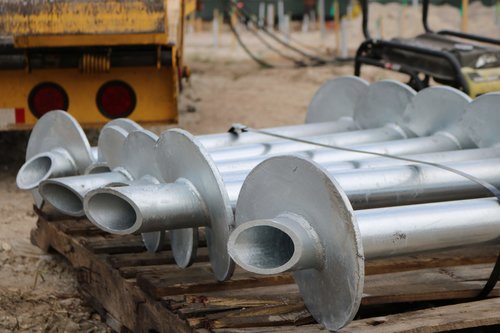Helical piers/piles are a popular, cost-saving approach to a wide variety of residential, industrial and commercial buildings foundation and earth support projects. They are often the first choice of contractors, structural engineering professionals, and architects due to their many savings, installation and environmental advantages. Helical piers are an especially popular solution for Florida beachfront properties.

How Helical Piers/Piles Work
Helical piles, which you may hear referred to also as helical piers or screw piles, were first invented by an Irish engineer in the early 19th century. Alexander Mitchell used his remarkable, economical construction technology for stabilizing moorings and lighthouses built over sand or mud. Early piles were made from wrought or cast iron.
Used vertically, they cost-effectively transfer the higher load-bearing capacity of denser subsoils to the surface where the soils may be soft and weak. Screw piles are also ideal for your soil or structure retention projects when installed horizontally or at in-between angles.
Today’s helical piers are made from either round or square extruded steel shafts with one or more welded helical plates per shaft. The plates both slice into the ground while providing compression, lateral and uplift support to the shaft. Pile segments are added via couplings to increase pier depth.
The Many Benefits of Helical Pile Foundation Systems
Perhaps more than any other style of deep foundation support, helical piles have a long list of advantages as a support solution for your next pre-construction or remediation activity that offer meaningful cost savings.
Ease of Installation
The installation of helical piles is accomplished with a hydraulic torque motor mounted to portable torque installation equipment. Installation is rapid, especially when compared to concrete structures installation. In a matter of a few hours, a dozen or more screw piers can be installed with minimal site impact.
During foundation, retaining wall or marine structure installations, precise placement of support structures is critical. Especially with handheld torque installation equipment, pier surface and depth placement are exact. Additionally, if engineering plans change mid-project that require moving piers, they are easily extracted and repositioned.
Immediate Loading
As the installation of a pile progresses, higher torque is required to screw piers into the denser earth below. Higher torques mean higher load-bearing capacity at the surface and great axial load capacity for the pier. Once set at the proper depth, a pier’s load capacity is immediately available to you. Compare that to concrete foundations that require extensive excavation and cure time.
Functional Versatility
Because of their ability to provide strength in more than one direction, you should consider helical piles for projects where concrete support structures are impractical. Most often, these piers are installed vertically, but horizontal or angular installation is easily accomplished as well.
This makes them especially useful for your earth retention projects or lateral support of walls and foundations. In Florida, they are ideal for new seawall construction and for repairing aged or damaged sea walls by creating tension inward toward the ground.
Helical piers also require little clearance, which makes them a preferred solution when your site’s clearances are minimal or other structures are close by.
Outstanding Cost Savings
Except in cases of foundation retrofit that may require exposing footings, there is no excavation required to install helical piers. That means there is no hauling of spoils either. Additionally, the cost of concrete, spillage and the delays while it cures are avoided.
Because of their adaptability for an array of project types, you will also find that they cut down on pre-construction planning and prep activities. All of these factors taken together mean helical piles are an exceptionally economical solution for ground support and retention.
Environmentally Beneficial
It is clear that compared to concrete foundations, the installation of helical piers almost completely eliminates site damage and cleanup costs. Additionally, fuel costs associated with concrete are significantly reduced.
Another immediate environmental benefit is that pier installation produces minimal vibration, which is critical in sensitive areas or when you are working close to occupied buildings.
Helical piles have another significant environmental advantage. Even years after installation, they can be easily removed if necessary and reused on other projects.
A Wide Array of Applications
For commercial buildings, homes and industrial sites located anywhere from the mountains to the sea, helical piles are often the most practical, durable and cost-effective solution for support and retention projects.
New Construction
In new construction, helical screw piles are used for decks over earth or water, pedestrian bridges, and boardwalks. You will find them indispensable for beachfront projects such as seawalls, bulkheads, pipe anchors or boat moorings as they can penetrate the water bottom through sand and silt. They are ideal for towers plus signage and lighting supports too.
Retrofitting of Existing Structures
For improving soil slippage, helical piers are often used to improve slab support, tying back retaining walls to solid earth when repairing cracked Florida seawalls. They can effectively provide lateral support to existing foundations or when leveling foundations or other concrete structures that have settled.
For Your Next Ground Support or Retention Project
Alexander Mitchell, back in the 1830s, could not have imagined the wide assortment of solutions of which his helical pier invention would become a critical part. Given their cost savings, installation versatility at nearly any location and applicability to so many types of structures, your own use for helical piers is limited only by your imagination.
Since 2007, helical piles are ICC-ES approved for AC358 Acceptance Criteria for Helical Foundation Systems and Devices. As of 2009, they are included in Chapter 18 of the International Building Code.
When faced with any type of ground or soil retention, industrial building support or residential project where you might normally consider concrete structures, look to helical piers for a more economical, time-saving and efficient solution.